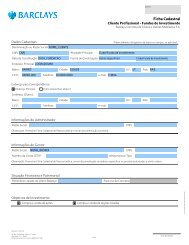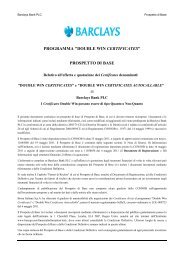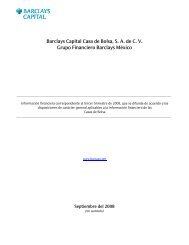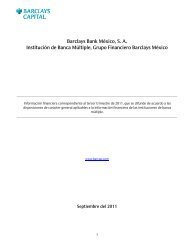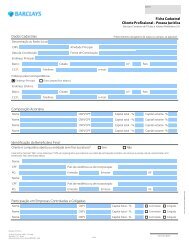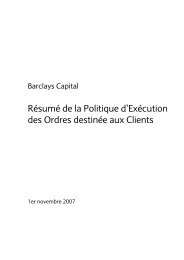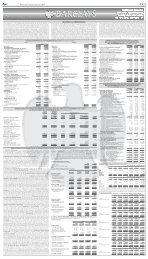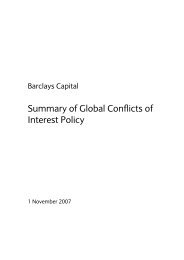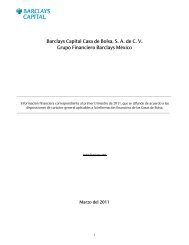consolidated statement of financial condition - Barclays Capital
consolidated statement of financial condition - Barclays Capital
consolidated statement of financial condition - Barclays Capital
- No tags were found...
Create successful ePaper yourself
Turn your PDF publications into a flip-book with our unique Google optimized e-Paper software.
CONSOLIDATEDSTATEMENTOF FINANCIALCONDITIONBARCLAYS CAPITAL INC.AND SUBSIDIARYDecember 31, 2010
NEW YORK – HEADQUARTERS745 Seventh AvenueNew York, NY 10019Tel: +1 212 526 7000<strong>Barclays</strong> <strong>Capital</strong> Inc.
Report <strong>of</strong> Independent AuditorsTo the Board <strong>of</strong> Directors and Stockholder <strong>of</strong><strong>Barclays</strong> <strong>Capital</strong> Inc. and SubsidiaryIn our opinion, the accompanying <strong>consolidated</strong> <strong>statement</strong> <strong>of</strong><strong>financial</strong> <strong>condition</strong> presents fairly, in all material respects, the<strong>financial</strong> position <strong>of</strong> <strong>Barclays</strong> <strong>Capital</strong> Inc. (the “Company”)and its Subsidiary at December 31, 2010 in conformity withaccounting principles generally accepted in the United States<strong>of</strong> America. This <strong>financial</strong> <strong>statement</strong> is the responsibility <strong>of</strong>the Company’s management. Our responsibility is to expressan opinion on this <strong>financial</strong> <strong>statement</strong> based on our audit. Weconducted our audit <strong>of</strong> this <strong>statement</strong> in accordance withauditing standards generally accepted in the United States <strong>of</strong>America. Those standards require that we plan and performthe audit to obtain reasonable assurance about whether the<strong>statement</strong> <strong>of</strong> <strong>financial</strong> <strong>condition</strong> is free <strong>of</strong> materialmis<strong>statement</strong>. An audit includes examining, on a test basis,evidence supporting the amounts and disclosures in the<strong>statement</strong> <strong>of</strong> <strong>financial</strong> <strong>condition</strong>, assessing the accountingprinciples used and significant estimates made bymanagement, and evaluating the overall <strong>statement</strong> <strong>of</strong><strong>financial</strong> <strong>condition</strong> presentation. We believe that our auditprovides a reasonable basis for our opinion.March 11, 20111
This page has been intentionally left blank.2
Consolidated Statement <strong>of</strong> Financial ConditionDecember 31, 2010(in millions, except share data)AssetsCash and cash equivalents $ 522Cash and securities segregated for regulatory and otherpurposes 5,544Collateralized agreements:Securities purchased under agreements to resell 159,454Securities borrowed 53,348Securities received as collateral (includes $15,54615,705pledged as collateral)Financial instruments owned, at fair value (includes$65,636 pledged as collateral) 79,361Receivables from brokers, dealers and clearingorganizations 7,250Receivables from customers 8,223Accrued interest and dividend receivables 383Other assets 317Total assets 330,107Liabilities and Stockholder’s EquityCollateralized financings:Securities sold under agreements to repurchase $ 225,105Securities loaned 17,585Obligation to return securities received as collateral 15,705Financial instruments sold, but not yet purchased, at fairvalue 43,996Payables to brokers, dealers and clearing organizations 6,464Payables to customers 9,247Short-term borrowings 218Accrued interest and dividend payables 293Other liabilities 1,651Total 320,264Commitments and Contingencies (see Note 15)Subordinated debt 2,500Stockholder’s equityCommon stock – no par value, 5,000 sharesauthorized, 10 shares issued and outstanding –Additional paid-in capital 6,085Retained earnings 1,267Accumulated other comprehensive loss, net <strong>of</strong> tax (9)Total stockholder’s equity 7,343Total liabilities and stockholder’s equity $ 330,107The accompanying notes are an integral part <strong>of</strong> this Consolidated Statement <strong>of</strong>Financial Condition.3
This page has been intentionally left blank.4
1. Organization<strong>Barclays</strong> <strong>Capital</strong> Inc. (the “Company”), a Connecticutcompany, is a registered securities broker-dealer,investment advisor and futures commission merchant(“FCM”), commodity pool operator, and commoditytrading advisor. The Company is headquartered in NewYork, with registered domestic branch <strong>of</strong>fices in Atlanta,Boston, Chicago, Dallas, Greenwich, Houston, LosAngeles, Media, Menlo Park, Miami, New York, PalmBeach, Philadelphia, San Juan, San Francisco, SantaMonica, Seattle, Washington D.C., and Wells, ME. TheCompany also has registered branch <strong>of</strong>ficesinternationally in Buenos Aires, Argentina andMontevideo, Uruguay. The Company’s client baseincludes money managers, insurance companies,pension funds, hedge funds, depository institutions,corporations, trust banks, money market and mutualfunds, domestic and international governmentalagencies, and central banks.The Consolidated Financial Statements include theaccounts <strong>of</strong> <strong>Barclays</strong> <strong>Capital</strong> Inc. and its wholly ownedsubsidiary, <strong>Barclays</strong> Business Credit LLC (“BBC”). TheCompany’s direct parent and sole stockholder is<strong>Barclays</strong> Group U.S., Inc. (“BGUS”). BGUS is a whollyowned subsidiary <strong>of</strong> <strong>Barclays</strong> Bank PLC (“BBPLC”) and isultimately owned by <strong>Barclays</strong> PLC (“BPLC”). Both BBPLCand BPLC are United Kingdom companies.The Company is BBPLC’s “4(k)(4)(E)” securitiessubsidiary under the Bank Holding Company Act, whichpermits it to engage in securities underwriting, dealing,or market-making activities. In its capacity as a brokerdealer,the Company clears derivative products forclients and affiliates on certain exchanges, including theChicago Mercantile Exchange. The Company’s activitiesinclude transactions in asset-backed securities, agencymortgage-backed securities, international debtsecurities, and other corporate related securities andsecurities lending. The Company is also a primary dealerin U.S. government securities.The Company has investment banking, capital markets,and private investment management businesses in theUnited States.<strong>Barclays</strong> Wealth is the wealth management division <strong>of</strong>BBPLC, operating through the Company in the Americas.<strong>Barclays</strong> Wealth in the Americas provides high net worth5
clients with brokerage and investment managementservices.BBC is a wholly owned subsidiary <strong>of</strong> the Company (the“Subsidiary”). The Subsidiary previously engaged ineconomic hedging for the Company by taking positionsin interest rate swaps with BBPLC. As <strong>of</strong>December 31, 2010, the Subsidiary is no longer acounterparty to these interest rate swaps. TheSubsidiary has also historically managed a portfolio <strong>of</strong>leveraged leases. As <strong>of</strong> December 31, 2010, BBC onlyhad one remaining lease.2. Significant Accounting PoliciesBasis <strong>of</strong> PresentationThe Consolidated Financial Statements have beenprepared in accordance with accounting principlesgenerally accepted in the United States <strong>of</strong> America(“GAAP”). Material intercompany balances andtransactions are eliminated upon consolidation. The U.S.Dollar is the functional currency <strong>of</strong> the Company. In theopinion <strong>of</strong> management, all adjustments necessary topresent fairly the <strong>financial</strong> position at December 31,2010 have been made.Use <strong>of</strong> EstimatesPreparation <strong>of</strong> the Consolidated Statement <strong>of</strong> FinancialCondition in accordance with GAAP requiresmanagement to make estimates and assumptions.These estimates and assumptions affect the reportedamounts <strong>of</strong> assets and liabilities and certain disclosuresat the date <strong>of</strong> the Consolidated Statement <strong>of</strong> FinancialCondition. Actual results could differ from theseestimates.Cash and cash equivalentsCash and cash equivalents consist <strong>of</strong> cash and highlyliquid investments with original maturities <strong>of</strong> less thanthree months. Cash on deposit with <strong>financial</strong> institutionsmay, at times, exceed federal insurance limits.Collateralized agreements and financingsCollateralized agreements consist <strong>of</strong> Securitiespurchased under agreements to resell (“Resaleagreements”) and Securities borrowed. Collateralizedfinancings consist <strong>of</strong> Securities sold under agreementsto repurchase (“Repurchase agreements”) and Securitiesloaned. Collateralized agreements and financings arepresented on a net-by-counterparty basis whentransactions are executed in accordance with master6
Transfers <strong>of</strong> Financial AssetsIn general, transfers <strong>of</strong> <strong>financial</strong> assets are accounted foras sales when the Company has relinquished controlover the transferred assets. A transferor is considered tohave relinquished control over the assets where (1) thetransferred assets are legally isolated from theCompany’s creditors, (2) the transferee can pledge orexchange the <strong>financial</strong> assets, and (3) the Companydoes not maintain effective control through the ability torepurchase the transferred assets before their maturity,or have the ability to unilaterally cause the holder toreturn the transferred assets. For transfers that are notaccounted for as sales, the <strong>financial</strong> assets remain inFinancial instruments owned, at fair value, in theConsolidated Statement <strong>of</strong> Financial Condition and thetransfers are accounted for as collateralized financing.Assets or liabilities that arise from the Company’scontinuing involvement with <strong>financial</strong> assets transferredinto securitization vehicles are measured at fair valueunder the Fair Value Option ASC 825, FinancialInstruments (“ASC 825”).Variable Interest EntitiesThe Company accounts for variable interest entities(“VIEs”) in accordance with ASC 810, Consolidation(“ASC 810”). VIEs are entities that lack one or more <strong>of</strong>the characteristics <strong>of</strong> a voting interest entity. Acontrolling <strong>financial</strong> interest in a VIE is present when anenterprise has a variable interest, or a combination <strong>of</strong>variable interests, that provides the enterprise with(1) the power to direct the activities <strong>of</strong> the VIE that mostsignificantly impact the VIE’s economic performance and(2) the obligation to absorb the VIE’s expected lossesand receive expected residual returns, or both, thatcould potentially be significant to the VIE. The enterprisewith a controlling <strong>financial</strong> interest, known as theprimary beneficiary, consolidates the VIE. In accordancewith ASC 810, the Company consolidates VIEs for whichit is the primary beneficiary. The Company reassesses itsinitial evaluation <strong>of</strong> an entity as a VIE and its initialdetermination <strong>of</strong> whether the Company is the primarybeneficiary <strong>of</strong> a VIE upon the occurrence <strong>of</strong> certainreconsideration events as outlined in ASC 810.Fair Value MeasurementsThe Company accounts for a significant portion <strong>of</strong> its<strong>financial</strong> instruments at fair value or considers fair value8
in their measurement, in accordance with ASC 820, FairValue Measurements and Disclosures (“ASC 820”).The Company’s Financial instruments owned, at fairvalue, and Financial instruments sold, but not yetpurchased, at fair value, are reflected in theConsolidated Statement <strong>of</strong> Financial Condition on atrade date basis. The fair value <strong>of</strong> a <strong>financial</strong> instrumentis the amount that would be received to sell an asset orpaid to transfer a liability in an orderly transactionbetween market participants at the measurement date(the exit price). Financial assets are marked to bid pricesand <strong>financial</strong> liabilities are marked to <strong>of</strong>fer prices. Incertain circumstances, where the Company acts as amarket maker, derivative <strong>financial</strong> instruments aremarked to mid-market prices. Fair value measurementsdo not include transaction costs.ASC 820 establishes a fair value hierarchy that prioritizesthe inputs to valuation techniques used to measure fairvalue. The hierarchy gives the highest priority tounadjusted quoted prices in active markets for identicalassets or liabilities (level 1 measurements) and thelowest priority to unobservable inputs (level 3measurements). The three levels <strong>of</strong> the fair valuehierarchy under ASC 820 are described below:• Level 1• Level 2• Level 3Unadjusted quoted prices in active marketsthat are accessible at the measurement datefor identical, unrestricted assets or liabilities;Quoted prices in markets that are notconsidered to be active, or <strong>financial</strong>instruments for which inputs to the valuationmethodology include quoted prices forsimilar assets and liabilities in active markets,and inputs that are observable for the assetor liability, either directly or indirectly, forsubstantially the full term <strong>of</strong> the <strong>financial</strong>instrument;Prices or valuations that require inputs thatare both significant to the fair valuemeasurement and unobservable.A <strong>financial</strong> instrument’s level within the fair valuehierarchy is based on the lowest level <strong>of</strong> any input that issignificant to the fair value measurement.The Company defines active markets for equityinstruments based on the average daily volume both in9
absolute terms and relative to the market capitalizationfor the instrument. The Company defines active marketsfor debt instruments based on the average daily volumeand the number <strong>of</strong> days with trading activity.Credit risk is an essential component <strong>of</strong> fair value. Cashproducts (e.g., bonds and loans) and derivative <strong>financial</strong>instruments (particularly those with significant futureprojected cash flows) trade in the market at levels whichreflect credit considerations. The Company calculatesthe fair value <strong>of</strong> derivative assets by discounting futurecash flows at a rate which incorporates counterpartycredit spreads and the fair value <strong>of</strong> derivative liabilitiesby discounting future cash flows at a rate whichincorporates the Company’s own credit spreads. Indoing so, credit exposures are adjusted to reflectmitigants, namely collateral agreements which reduceexposures based on triggers and contractual postingrequirements. The Company manages its exposure tocredit risk and will price, economically hedge, facilitateand intermediate trades that involve credit risk. TheCompany records liquidity valuation adjustments toreflect the cost <strong>of</strong> exiting concentrated risk positions,including exposure to the Company’s own credit spread.The Company has an established process fordetermining fair values. Fair value is based upon quotedmarket prices, where available. If listed prices or quotesare not available, fair value is based upon internallydeveloped models that primarily use, as inputs, marketbasedor independently sourced market parametersincluding, but not limited to, yield curves, interest rates,volatilities, equity or debt prices, foreign exchange rates,and credit curves. In addition to market information,models also incorporate transaction details, such asmaturity. Valuation adjustments may be made to ensurethat <strong>financial</strong> instruments are recorded at fair value.These adjustments include amounts to reflectcounterparty credit quality, constraints on liquidity, andunobservable parameters that are applied consistentlyover time.Level 1 and level 2 Financial instruments, at fairvalue. In determining fair value <strong>of</strong> <strong>financial</strong> instrumentsin level 1 and level 2 <strong>of</strong> the fair value hierarchy, theCompany separates its Financial instruments owned, atfair value and its Financial instruments sold, but not yetpurchased, at fair value into two categories: cashinstruments and derivative contracts.10
The valuation techniques and significant inputs used indetermining the fair values <strong>of</strong> cash instruments andderivative contracts classified within level 1 and level 2<strong>of</strong> the fair value hierarchy are as follows:• Cash instrumentsThe Company’s cash instruments are generallyclassified within level 1 or level 2 <strong>of</strong> the fair valuehierarchy because they are valued using quotedmarket prices, broker or dealer quotations, oralternative pricing sources with reasonable levels <strong>of</strong>price transparency. The types <strong>of</strong> instruments valuedbased on quoted market prices in active marketsinclude certain U.S. government obligations, othersovereign government obligations, actively tradedlisted equities and certain money market securities.Such instruments are generally classified within level 1<strong>of</strong> the fair value hierarchy. The Company does notadjust the quoted price for such instruments, even insituations where the Company holds a large positionand a sale could reasonably impact the quoted price.The types <strong>of</strong> instruments that trade in markets thatare not considered to be active, but are valued basedon quoted market prices, broker or dealer quotations,or alternative pricing sources with reasonable levels <strong>of</strong>price transparency include most government agencyobligations, investment-grade corporate bonds, certainmortgage products, less liquid publicly listed equities,and state, municipal and provincial obligations. Suchinstruments are generally classified within level 2 <strong>of</strong>the fair value hierarchy, and may be adjusted to reflectilliquidity and/or non-transferability, which aregenerally based on available market evidence, and mayincorporate management’s best estimate based onavailable market evidence.• Derivative ContractsDerivative contracts can be exchange-traded or overthe-counter(“OTC”). Exchange-traded derivatives,including equity options, typically fall within level 1 orlevel 2 <strong>of</strong> the fair value hierarchy, depending onwhether they are deemed to be actively traded or not.The Company generally values exchange-tradedderivatives using models which are calibrated tomarket clearing levels and eliminate timing differencesbetween the closing price <strong>of</strong> the exchange-tradedderivatives and their underlying <strong>financial</strong> instruments.11
In such cases, exchange-traded derivatives areclassified within level 2 <strong>of</strong> the fair value hierarchy.OTC derivatives, including to-be-announced (“TBA”)contracts, are valued using market transactions andother market evidence whenever possible, includingmarket-based inputs to models, model calibration tomarket clearing transactions, broker or dealerquotations, or alternative pricing sources withreasonable levels <strong>of</strong> price transparency. Where modelsare used, the selection <strong>of</strong> a particular model to valuean OTC derivative depends upon the contractual terms<strong>of</strong>, and specific risks inherent in, the instrument as wellas the availability <strong>of</strong> pricing information in the market.The Company generally uses similar models to valuesimilar instruments. Valuation models require a variety<strong>of</strong> inputs, including contractual terms, market prices,yield curves, credit curves, measures <strong>of</strong> volatility,prepayment rates, loss severity rates and correlations<strong>of</strong> such inputs. For OTC derivatives that trade in liquidmarkets, such as generic forwards, swaps and options,model inputs can generally be verified and modelselection does not involve significant managementjudgment. OTC derivatives are classified within level 2<strong>of</strong> the fair value hierarchy when all <strong>of</strong> the significantinputs can be corroborated to market evidence. Whenappropriate, valuations are adjusted for various factorssuch as liquidity, bid/<strong>of</strong>fer spreads, and creditconsiderations. Such adjustments are generally basedon available market evidence. In the absence <strong>of</strong> suchevidence, management’s best estimate is used.In accordance with guidance under ASC 210-20,Offsetting, (“ASC 210-20”), where the Company hasentered into a legally enforceable netting agreementwith counterparties, it reports derivative assets andliabilities, and any related cash collateral, net in theConsolidated Statement <strong>of</strong> Financial Condition. Netpresentation <strong>of</strong> derivative assets and liabilities, and anyrelated cash collateral, does not impact theclassification <strong>of</strong> the derivative instruments within thefair value hierarchy.Level 3 Financial instruments, at fair value. Certaincash instruments are classified within level 3 <strong>of</strong> the fairvalue hierarchy because they trade infrequently andtherefore have little or no price transparency. Suchinstruments include less liquid corporate debt securities(including distressed debt instruments), certain types <strong>of</strong>12
equities, and less liquid mortgage-backed securities andasset-backed securities. Absent evidence to thecontrary, instruments classified within level 3 <strong>of</strong> the fairvalue hierarchy are initially valued at transaction price,which is considered to be the best initial estimate <strong>of</strong> fairvalue. Accordingly, when a pricing model is used tovalue such an instrument, the model is adjusted so thatthe model value at inception equals the transactionprice. Subsequent to the transaction date, the Companyuses other methodologies to determine fair value, whichvary based on the type <strong>of</strong> instrument, as describedbelow. Regardless <strong>of</strong> methodology, valuation is adjustedgenerally only when changes to inputs and assumptionsare corroborated by evidence such as transactions insimilar instruments, completed or pending third-partytransactions in the underlying investment or comparableentities, and other transactions across the capitalstructure, <strong>of</strong>ferings in the equity or debt capital markets,and changes in <strong>financial</strong> ratios or expected cash flows.Valuations are further corroborated by values realizedupon sales <strong>of</strong> the Company’s level 3 assets. Whenobservable inputs are not available, the Company usesmarket valuation techniques to record assets andliabilities at fair value. The valuation techniques andsignificant inputs used in determining the fair value <strong>of</strong>each class <strong>of</strong> cash instrument and derivative contractsclassified within level 3 <strong>of</strong> the fair value hierarchy are asfollows:• Equities and convertibles. For equities andconvertibles, the level 3 population is comprised <strong>of</strong>convertible bonds. The valuation or significant inputsare obtained from various market data sources andapplied to the positions.• Corporate debt securities. Valuations are generallybased on discounted cash flow techniques, for whichthe significant inputs are the amount and timing <strong>of</strong>expected future cash flows, market yields, andrecovery assumptions. The significant inputs aregenerally determined based on relative valueanalyses, which incorporate comparisons both tocredit default swaps that reference the sameunderlying credit risk and to other debt instrumentsfor the same issuer for which observable prices orbroker quotes are available.13
• Mortgage-backed and other asset-backedsecurities. Securities backed by real estate orcollateralized by specific assets may be tranchedinto varying levels <strong>of</strong> subordination. Due to thenature <strong>of</strong> these instruments, valuation techniquesvary by instrument, but are generally based onrelative value analyses, discounted cash flowtechniques and a combination there<strong>of</strong>.For securities backed by commercial real estate or byspecific assets, significant inputs for these valuationsinclude transactions in both the underlying collateraland instruments with the same or substantially thesame underlying collateral, credit default swapprices, current levels and trends <strong>of</strong> market indices(such as the CMBX), market yields, and other factors(such as the operating income generated by theunderlying collateral) which are used in determiningthe amount and timing <strong>of</strong> expected future cashflows.Valuations <strong>of</strong> securities backed by residential realestate are based on both proprietary and industryrecognized models (including Intex and Bloomberg),and discounted cash flow techniques. The mostsignificant inputs to the valuation <strong>of</strong> theseinstruments are rates and timing <strong>of</strong> delinquencies,the rates and timing <strong>of</strong> prepayments, and default andloss expectations, which are driven in part byhousing prices. The significant inputs are determinedbased on relative value analyses, which incorporatecomparisons to instruments with similar collateraland risk pr<strong>of</strong>iles, including relevant indices such asthe ABX.Customer Securities TransactionsCustomer securities transactions are recorded on asettlement date basis in the Consolidated Statement <strong>of</strong>Financial Condition. Securities owned by customers,including those that collateralize margin or other similartransactions, and are held for clients in an agency orfiduciary capacity by the Company, are not consideredassets <strong>of</strong> the Company and are not included in theConsolidated Statement <strong>of</strong> Financial Condition.However, in the event <strong>of</strong> fails to deliver or receive, theCompany records corresponding Receivables fromcustomers or Payables to customers, respectively. TheCompany monitors the market value <strong>of</strong> collateral heldand the market value <strong>of</strong> securities receivable from14
customers. It is the Company’s policy to request andobtain additional collateral when appropriate.Receivables from and Payables to Brokers, Dealersand Clearing OrganizationsReceivables from and payables to brokers, dealers andclearing organizations consist primarily <strong>of</strong> fails to deliveror receive, margin balances, deposits at clearingorganizations, and amounts related to unsettledsecurities trading activity.Receivables from and Payables to CustomersReceivables from and payables to customers includeamounts due on cash and margin transactions.Securities owned by customers, including those thatcollateralize margin or similar transactions, are notreflected in the Consolidated Statement <strong>of</strong> FinancialCondition.Share-Based CompensationThe Company applies ASC 710, Compensation – General(“ASC 710”), which focuses primarily on accounting fora transaction in which an entity obtains employeeservices in exchange for share-based payments.Retirement BenefitsThe Company accounts for retirement benefits inaccordance with ASC 715, Compensation – RetirementBenefits (“ASC 715”). ASC 715 requires an entity torecognize in its Consolidated Statement <strong>of</strong> FinancialCondition the funded status <strong>of</strong> its defined benefitpension and postretirement plans, measured as thedifference between the fair value <strong>of</strong> the plan assets andthe benefit obligation.Income TaxesTax provisions are computed in accordance with ASC740, Income Taxes (“ASC 740”). Deferred tax assets andliabilities are recognized for temporary differencesbetween the <strong>financial</strong> reporting and tax bases <strong>of</strong> theCompany’s assets and liabilities. Valuation allowancesare established to reduce deferred tax assets to theamount that more likely than not will be realized. TheCompany’s deferred tax assets and tax liabilities arepresented on a net basis as a component <strong>of</strong> Otherassets in the Consolidated Statement <strong>of</strong> FinancialCondition.The Company and its Subsidiary are included in thefederal <strong>consolidated</strong> income tax return <strong>of</strong> BGUS. TheCompany and its Subsidiary file state and local income15
tax returns in New York State and New York City, as wellas other state and local jurisdictions, with affiliatedcompanies. The Company has an intercompany taxsharing agreement with BGUS under which it computesand settles its current and deferred income taxreceivable/payable on a periodic basis through itsaccount receivable/payable with BGUS.The Company follows guidance under ASC 740 whichsets out a consistent framework to determine theappropriate level <strong>of</strong> tax reserves to maintain foruncertain tax positions. Under ASC 740, the Companydetermines whether it is more likely than not that anincome tax position will be sustained upon examinationby tax authorities. Sustainable income tax positions aremeasured in the Consolidated Statement <strong>of</strong> FinancialCondition at the largest amount <strong>of</strong> benefit that is morelikely than not to be realized upon ultimate settlement.Recent Accounting DevelopmentsDisclosures about the credit quality <strong>of</strong> financingreceivables and the allowance for credit lossesIn July 2010, the FASB issued Accounting StandardsUpdate (“ASU”) No. 2010-20, Disclosures about thecredit quality <strong>of</strong> financing receivables and the allowancefor credit losses. ASU No. 2010-20 addresses concernsabout the sufficiency, transparency, and robustness <strong>of</strong>credit risk disclosures for finance receivables and therelated allowance for credit losses. ASU No. 2010-20requires that entities disclose information atdisaggregated levels, specifically defined as “portfoliosegments” and “classes.” Among other things, theexpanded disclosures include roll-forward schedules <strong>of</strong>the allowance for credit losses and information regardingthe credit quality <strong>of</strong> receivables (including their aging) as<strong>of</strong> the end <strong>of</strong> a reporting period. Certain financereceivables that were modified during a reporting periodand those that were previously modified and have redefaultedrequire enhanced disclosures. For nonpublicentities, the disclosures are effective for interim andannual periods ending after December 15, 2011. Theadoption <strong>of</strong> this standard is not expected to have amaterial effect on the Company’s ConsolidatedStatement <strong>of</strong> Financial Condition.16
Accounting for Share-Based Awards – Effect <strong>of</strong>Denominating the Exercise Price <strong>of</strong> a Share-BasedPayment Award in the Currency <strong>of</strong> the Market inwhich the Underlying Equity Security TradesIn April 2010, the FASB issued ASU No. 2010-13, Effect<strong>of</strong> Denominating the Exercise Price <strong>of</strong> a Share-BasedPayment Award in the Currency <strong>of</strong> the Market in whichthe Underlying Equity Security Trades – an update toASC 718, Compensation. This ASU clarifies that if theexercise price <strong>of</strong> a share-based payment is denominatedin the currency <strong>of</strong> a market in which a substantialportion <strong>of</strong> the entity’s equity securities trades, the awardshall not be classified as a liability if it otherwise qualifiesfor equity classification. ASU No. 2010-13 is effective forfiscal quarters beginning on or after December 15, 2010.The adoption <strong>of</strong> this standard is not expected to have amaterial effect on the Company's ConsolidatedStatement <strong>of</strong> Financial Condition as the Company’scurrent accounting is in compliance with this guidance.Accounting for Derivatives and Hedging – ScopeException Related to Embedded Credit DerivativesIn March 2010, the FASB issued ASU No. 2010–11,Derivatives and Hedging: Scope Exception Related toEmbedded Credit Derivatives. This pronouncementclarifies that the scope exception within ASC 815 –Derivatives and Hedging, related to embedded creditderivatives only applies to the transfer <strong>of</strong> credit risk inthe form <strong>of</strong> subordination <strong>of</strong> one <strong>financial</strong> instrument toanother. All other embedded derivatives would need tobe analyzed for bifurcation in accordance with ASC 815.ASU No. 2010-11 is effective for the Company’s 2010Consolidated Statement <strong>of</strong> Financial Condition. Thisstandard did not have a material effect on theCompany's Consolidated Statement <strong>of</strong> FinancialCondition.Fair value measurements and disclosures – Improvingdisclosures about fair value measurementsIn January 2010, the FASB issued ASU No. 2010-06, FairValue Measurements and Disclosures – ImprovingDisclosures about Fair Value Measurements. ASU No.2010–06 requires additional disclosures about activitythat occurred during the year related to assets classifiedwithin level 3 fair value measurements as well astransfers in and out <strong>of</strong> level 1 and level 2 fair valuemeasurements. In addition, it provides clarification toexisting guidance, specifically requiring disaggregation<strong>of</strong> assets classes within the existing ASC 820 disclosures17
and requiring expanded information on inputs andvaluation techniques. The new requirements areeffective for the Company’s 2010 ConsolidatedStatement <strong>of</strong> Financial Condition, except for the level 3rollforward on a gross basis, which is effective for fiscalyears beginning after December 15, 2010. The Companyadopted this guidance, except for the level 3 rollforwardon a gross basis, for the year ended December 31, 2010.Additional disclosures required upon adoption <strong>of</strong> thisASU are included in Notes 2 and 4. The requirement topresent the level 3 rollforward on a gross basis is not yeteffective and is therefore not included in the Company’sConsolidated Statement <strong>of</strong> Financial Condition.Accounting for Transfers <strong>of</strong> Financial Assets andConsolidation <strong>of</strong> Variable Interest EntitiesIn June 2009, the FASB issued ASU No. 2009-16,Accounting for Transfers <strong>of</strong> Financial Assets, and ASU2009–17, Consolidations, Improvements to FinancialReporting by Enterprises involved with Variable InterestEntities. ASU No. 2009-16 eliminates the concept <strong>of</strong> aqualified special purpose entity (“QSPE”), changes therequirements for derecognizing <strong>financial</strong> assets, andrequires additional disclosures about transfers <strong>of</strong><strong>financial</strong> assets, including securitization transactions andcontinuing involvement with transferred <strong>financial</strong> assets.ASU No. 2009-17 changes the determination <strong>of</strong> when aVIE should be <strong>consolidated</strong>. Under ASU No. 2009-17, thedetermination <strong>of</strong> whether to consolidate a VIE is basedon the power to direct the activities <strong>of</strong> the VIE that mostsignificantly impact the VIE’s economic performancetogether with either the obligation to absorb losses orthe right to receive benefits that could be significant tothe VIE, as well as the VIE’s purpose and design. ASU No.2009-16 and ASU No. 2009-17 are effective for fiscalyears beginning after November 15, 2009. The Companyadopted ASU Nos. 2009-16 and 2009-17 as <strong>of</strong>January 1, 2010 and reassessed whether it was theprimary beneficiary <strong>of</strong> any VIEs in which it had variableinterest. The adoption <strong>of</strong> this standard did not have amaterial effect on the Company’s ConsolidatedStatement <strong>of</strong> Financial Condition. Additional disclosuresrequired upon adoption <strong>of</strong> the ASU are included in Note5.18
3. Cash and Securities Segregated for Regulatoryand Other PurposesCash and cash equivalents <strong>of</strong> $2,677 million aresegregated under the Commodity Exchange Act.Additionally, cash <strong>of</strong> $2,867 million is segregated inspecial reserve bank accounts for the exclusive benefit<strong>of</strong> customers under Rule 15c3-3 <strong>of</strong> the Securities andExchange Act and for the reserve requirement forProprietary Accounts for Introducing Broker-Dealers(“PAIB”) (for further discussion, see Note 20 “RegulatoryRequirements”).4. Financial InstrumentsFair Value <strong>of</strong> Financial InstrumentsThe following table sets forth the Company’s <strong>financial</strong>instruments owned, at fair value, including thosepledged as collateral and <strong>financial</strong> instruments sold, butnot yet purchased, at fair value under ASC 820 as <strong>of</strong>December 31, 2010 (in millions):FinancialinstrumentsownedFinancialinstrumentssold, but not yetpurchasedMoney market instruments $ 1,949 $ –Governments and agencies:Government securities 20,028 29,379Agency securities 41,059 6,587Mortgage and other ABS:Commercial mortgagebackedsecurities 1,314 –Residential mortgagebackedsecurities 1,181 –Other asset-backedsecurities 944 4Corporate debt securities 5,551 1,750Equities and convertibles 5,622 4,477Derivative contracts, net:Equity options 315 239TBA contracts 1,397 1,553Other 1 7$ 79,361 $ 43,996Financial instruments sold, but not yet purchased, at fairvalue represent obligations <strong>of</strong> the Company to delivereither a specified security or cash at a contracted price.The Company has recorded this liability in theConsolidated Statement <strong>of</strong> Financial Condition as <strong>of</strong>December 31, 2010, at fair value. However, thesetransactions are subject to market risk if the marketprice <strong>of</strong> these <strong>financial</strong> instruments increasessubsequent to the date <strong>of</strong> the Consolidated Statement19
<strong>of</strong> Financial Condition. The Company seeks to limit thisrisk by holding <strong>of</strong>fsetting <strong>financial</strong> instrument positionsor other <strong>financial</strong> instruments.Derivative ContractsThe fair value <strong>of</strong> derivative transactions is reported in theConsolidated Statement <strong>of</strong> Financial Condition as assetsor liabilities in Financial instruments owned or Financialinstruments sold, but not yet purchased, as applicable.Derivatives are presented at fair value in the table belowon a gross basis, prior to the application <strong>of</strong> the impact <strong>of</strong>counterparty netting under ASC 210-20. These balancesgenerally represent future commitments to exchangepayment streams based on contract or notionalamounts or to purchase or sell other <strong>financial</strong>instruments or physical assets at specified terms on aspecified date. Both over-the-counter and exchangetradedderivatives are reflected.The Company enters into trading derivative contracts tosatisfy the needs <strong>of</strong> its clients, for trading purposes andto manage the Company’s exposure to market andcredit risks resulting from its trading activities. As part <strong>of</strong>the Company’s risk management policies, the Companymanages risks associated with derivatives on anaggregate basis. The Company uses industry standardderivative contracts whenever appropriate.The following table sets forth the fair value and thenotional value <strong>of</strong> the Company’s derivative contracts bymajor product type on a gross basis as <strong>of</strong>December 31, 2010. Gross fair values in the table belowexclude the effects <strong>of</strong> both netting under enforceablenetting agreements and netting <strong>of</strong> cash received orposted pursuant to credit support agreements, andtherefore are not representative <strong>of</strong> the Company’sexposure (in millions):DerivativeAssetsDerivativeLiabilitiesContract/NotionalEquity options $ 4,055 $ 3,979 $ 231,961TBA contracts 1,397 1,553 316,726Other 1 7 74,109Gross fair value <strong>of</strong> derivativecontracts $ 5,453 $ 5,539 $ 622,796Counterparty netting (3,740) (3,740)Total included in FinancialInstruments owned, at fair value $ 1,713Total included in FinancialInstruments sold, but not yetpurchased, at fair value $ 1,79920
While the notional amounts disclosed above give anindication <strong>of</strong> the volume <strong>of</strong> the Company’s derivativeactivity, for most derivative transactions, the notionalamount is not exchanged but rather used as a referenceto calculate payments.As <strong>of</strong> December 31, 2010, the Company had norequirements to post additional collateral underderivative contracts, or terminate these transactions inthe event <strong>of</strong> a reduction in the Company’s long-termcredit rating.Fair Value HierarchyThe following table presents the Financial instrumentsowned, at fair value and Financial instruments sold, butnot yet purchased, at fair value as <strong>of</strong> December 31, 2010,by caption in the Consolidated Statement <strong>of</strong> FinancialCondition and by the valuation hierarchy as described inNote 2 “Significant Accounting Policies” (in millions):Fair Value Measurements on a recurring basis as <strong>of</strong>December 31, 2010Netting and Total CarryingLevel 1 Level 2 Level 3 Collateral (a) ValueAssetsFinancial instruments owned, atfair valueMoney market instruments $ – $ 1,949 $ – $ – $ 1,949Government and agencies:Government securities 10,774 9,254 – – 20,028Agency securities – 41,059 – – 41,059Mortgage and other ABS:Commercial MBS – 1,220 94 – 1,314Residential MBS – 628 553 – 1,181Other ABS – 843 101 – 944Corporate debt securities 8 5,527 16 – 5,551Equities and convertibles 4,667 941 14 – 5,622Derivative contracts:Equity options 4,046 9 – (3,740) 315TBA contracts – 1,397 – – 1,397Other derivatives – 1 – – 1Total Financial instrumentsowned $ 19,495 $ 62,828 $ 778 $ (3,740) $ 79,361Securities segregated forregulatory purposes $ – $ – $ – $ – $ –LiabilitiesFinancial Instruments sold, butnot yet purchased, at fairvalueMoney market instruments $ – $ – $ – $ – $ –Government and agencies:Government securities 23,971 5,408 – – 29,379Agency securities – 6,587 – – 6,587Mortgage and other ABS:Commercial MBS – – – – –Residential MBS – – – – –Other ABS – 4 – – 4Corporate debt securities 1 1,743 6 – 1,750Equities and convertibles 4,460 16 1 – 4,477Derivative contracts:Equity options 3,979 – – (3,740) 239TBA contracts – 1,553 – – 1,553Other derivatives – 7 – – 7Total Financial instruments sold,but not yet purchased $ 32,411 $ 15,318 $ 7 $ (3,740) $ 43,996(a) For a discussion on the Company’s netting <strong>of</strong> derivative contracts, see Note 2,“Significant Accounting Policies”.21
On March 31, 2010, the Company transferred long andshort assets with a fair value <strong>of</strong> $10,398 million and$4,390 million, respectively, from level 1 to level 2 due towidening bid-<strong>of</strong>fer spreads and price dispersionobserved in the market. The transfers between otherlevels were not significant.5. Securitization Activities and Variable InterestEntitiesRe-securitizations <strong>of</strong> residential and commercialmortgage-backed securitiesThe Company repackages assets and mortgage-backedsecurities by selling them into securitization vehicles thatissue beneficial interests to investors. The securitizationvehicles qualify as VIEs under ASU No. 2009-17. Whilethe Company may retain interests in the securitized<strong>financial</strong> assets through holding tranches <strong>of</strong> thesecuritizations, the Company is generally not required toconsolidate these VIEs as it does not have the power todirect the significant activities <strong>of</strong> the entities. TheCompany acts as underwriter <strong>of</strong> the beneficial intereststhat are sold to investors. The Company de-recognizesthe transferred securities when it relinquishes control.The transferred assets are recorded at fair value prior tothe securitizations.For the year ended December 31, 2010, the Companysold securities with a fair value <strong>of</strong> $4,506 million (parvalue <strong>of</strong> $5,981 million) into securitization vehicles, <strong>of</strong>which $1,937 million were investment grade and $2,569million were non-investment grade. Retained interestsrelated to the Company’s continuing involvement arerecorded at fair value and are included in Financialinstruments owned, at fair value in the ConsolidatedStatement <strong>of</strong> Financial Condition. As <strong>of</strong> December 31,2010, the Company recorded $525 million <strong>of</strong> retainedinterests in these securitizations, <strong>of</strong> which $330 millionare investment grade and $195 million are noninvestmentgrade. The maximum amount <strong>of</strong> loss thatthe Company is exposed to is the amount recordedrelated to these positions in the Consolidated Statement<strong>of</strong> Financial Condition as the Company has no otherrequirements to support these vehicles.22
The following table sets forth the weighted average keyeconomic assumptions used in measuring the fair value<strong>of</strong> the Company’s retained interests and the sensitivity<strong>of</strong> this fair value to immediate adverse changes <strong>of</strong> 10%and 20% in those assumptions (in millions):Mortgage-backed securitiesFair value <strong>of</strong> retained interests $ 525Weighted Average Life (years) 2.91Constant prepayment rate 8.07%Impact <strong>of</strong> 10% adverse change (11.02)Impact <strong>of</strong> 20% adverse change (13.70)Discount rate 7.81%Impact <strong>of</strong> 10% adverse change (19.76)Impact <strong>of</strong> 20% adverse change (30.80)Loss severity 54.26%Impact <strong>of</strong> 10% adverse change (19.62)Impact <strong>of</strong> 20% adverse change (27.99)Loss severity is the percentage <strong>of</strong> the defaulted balancewhich is not covered by liquidation proceeds (recoveries)and therefore passed through as a loss to thesecuritization trust. It does not consider the probability<strong>of</strong> default as changes in the probability <strong>of</strong> default are notexpected to have a significant adverse effect on thesecurities held by the Company. Additionally, thepreceding table does not give effect to the <strong>of</strong>fsettingbenefit <strong>of</strong> other <strong>financial</strong> instruments that are held tomitigate risks inherent in these retained interests. Theimpact <strong>of</strong> a change in a particular assumption iscalculated independently <strong>of</strong> changes in any otherassumption. Changes in fair value <strong>of</strong> the retainedinterests based on an adverse variation in assumptionsgenerally cannot be extrapolated because therelationship <strong>of</strong> the change in assumptions to the changein fair value is not usually linear. In practice,simultaneous changes in assumptions might magnify orcounteract the sensitivities disclosed above.Agency securitizationsAs part <strong>of</strong> the ordinary course <strong>of</strong> business, the Companyowns interests in agency securitizations and othersecuritization vehicles established by third parties that itdoes not consolidate as it does not have the power todirect the significant activities <strong>of</strong> those entities underASU 2009-17. During the year ended December 31, 2010,the Company sold $51,541 million <strong>of</strong> U.S. governmentagency-issued securities to the agencies that wereplaced into their securitization vehicles. The Company23
generally de-recognizes those securities from itsConsolidated Statement <strong>of</strong> Financial Condition as it hasrelinquished control over those securities. However,during 2010, the Company sold approximately $1,912million <strong>of</strong> U.S. government agency-issued securities to beincluded in agency securitizations and in connection withthe transfer, retained a call option that allowed it toreacquire the assets at some point post securitization at afixed price. As such, the Company did not relinquishcontrol over the transferred assets and was required tocontinue to record the transferred assets in itsConsolidated Statement <strong>of</strong> Financial Condition. Duringthe year ended December 31, 2010 the Companyexercised certain call options and reacquired $1,156million <strong>of</strong> the transferred assets. Additionally, theCompany sold a majority <strong>of</strong> the remaining call options toBBPLC which, due to the fact that the Company no longerretained control over the transferred assets, allowed it tode-recognize $746 million <strong>of</strong> securities. Due to the calloptions retained, the Company was unable toderecognize securities sold to agency securitizations inthe amount <strong>of</strong> $10 million, and recorded a correspondingamount in Other liabilities for the cash received.The Company’s positions in and maximum exposure toloss in all agency securitization vehicles, including thoseestablished by third parties, as <strong>of</strong> December 31, 2010was $5,267 million, and was recorded as Financialinstruments owned, at fair value in the ConsolidatedStatement <strong>of</strong> Financial Condition.Municipal Securities Tender Option Bond (“TOB”)TrustsThe Company forms customer TOB trusts throughwhich customers finance investments in municipalsecurities. TOB trusts hold tax-exempt securities issuedby state or local municipalities. The trusts are typicallysingle-issuer trusts whose assets are purchased fromthe Company via the primary and secondary market. T<strong>of</strong>und the purchase <strong>of</strong> their assets, the trusts issue longtermsenior floating rate notes (“Floaters”) and juniorresidual securities (“Residuals”). The holder <strong>of</strong> theResiduals generally has the ability to direct decisions thatsignificantly impact the economic performance <strong>of</strong> theTOB trusts through its ability to liquidate the TOB trustand ultimately direct the sale <strong>of</strong> the municipal bondsowned by that trust. Liquidity agreements are providedto the trust by BBPLC and the Company serves asremarketing agent for the Floaters. Floater holders have24
an option to tender the Floaters they hold back to thetrust periodically. The Company, in its capacity as aremarketing agent, facilitates the sale <strong>of</strong> the Floaters tothird parties at inception <strong>of</strong> the trust and facilitates thereset <strong>of</strong> the Floater coupon, and tenders <strong>of</strong> Floaters. IfFloaters are tendered and the Company (in its role asremarketing agent) is unable to find a new investorwithin a specified period <strong>of</strong> time, it can declare a failedremarketing (in which case the trust is unwound) or maychoose to buy the Floaters into its own inventory andmay continue to try to sell it to a third-party investor. N<strong>of</strong>ailed remarketings on trusts formed by the Companywere declared during the year.The Company considers the customer TOB trusts to beVIEs. The trusts are not <strong>consolidated</strong> by the Companybecause the third-party investors hold the Residual andFloater interests in the trusts and because theCompany’s involvement with the trusts is limited to itsrole as remarketing agent.During the year ended December 31, 2010, theCompany sold $952 million <strong>of</strong> its municipal bonds to thecustomer TOB trusts. The Company generallyde-recognizes those bonds from its ConsolidatedStatement <strong>of</strong> Financial Condition as it has relinquishedcontrol over those securities. As <strong>of</strong> December 31, 2010,the Company held $33 million <strong>of</strong> the Floater inventoryrelated to the customer TOB programs as part <strong>of</strong> regularremarketing activity, recorded as Financial instrumentsowned, at fair value in the Consolidated Statement <strong>of</strong>Financial Condition.25
6. Receivables from and Payables to Brokers,Dealers and Clearing OrganizationsReceivables from and payables to brokers, dealers andclearing organizations, as reported in the ConsolidatedStatement <strong>of</strong> Financial Condition at December 31, 2010consist <strong>of</strong> the following (in millions):Receivablesfrom Brokers,Dealers andClearingOrganizationsPayables toBrokers,Dealers andClearingOrganizationsSecurities failed to deliver/receive $ 2,702 $ 3,353Margin balances 4,436 2,497Fees and commissionsreceivable/payable 21 258Trade date payables, net (settlement) – 222Other 91 134$ 7,250 $ 6,4647. Other Assets and Other LiabilitiesAt December 31, 2010, Other assets primarily consist <strong>of</strong>deferred state tax assets <strong>of</strong> $111 million, current statetax receivables <strong>of</strong> $65 million, identifiable intangibleassets, which consists primarily <strong>of</strong> customer lists <strong>of</strong>$32 million, and loans to employees <strong>of</strong> $25 million.Other liabilities primarily consist <strong>of</strong> accruedcompensation <strong>of</strong> $1,054 million, current federal taxliabilities <strong>of</strong> $201 million, and $105 million for accruedoperating expenses.8. Income TaxesAt December 31, 2010, the Company recorded$535 million <strong>of</strong> net deferred tax assets. This balance iscomprised <strong>of</strong> deferred tax assets <strong>of</strong> $551 millionresulting from temporary differences primarily related todeferred compensation and stock-based compensation.These deferred tax assets were <strong>of</strong>fset by deferred taxliabilities <strong>of</strong> $16 million resulting from temporarydifferences primarily related to leases. Net federaldeferred tax balances are recorded as accountsreceivable from BGUS as a component <strong>of</strong> Other assets inthe Consolidated Statement <strong>of</strong> Financial Condition, andare settled on a periodic basis. Cumulatively,$425 million <strong>of</strong> net federal deferred tax assets have beensettled with BGUS.26
The Company is required to assess the likelihood thatdeferred tax assets will be realized using a more-likelythan-notcriteria. To the extent this criteria is not met,the Company is required to establish a valuationallowance against the deferred tax assets. No valuationallowance is recorded at December 31, 2010 becausethe Company believes the net deferred tax assets willmore-likely-than-not be realized.The Company’s unrecognized tax benefits, includinginterest <strong>of</strong> $18 million, are recorded in the ConsolidatedStatement <strong>of</strong> Financial Condition as current incometaxes payable, included in Other liabilities. The Companyhas not recorded any amounts for penalties related to itsunrecognized tax benefits. In connection with theLehman acquisition, and due to the complexitiesinvolved with the transaction, there are potentiallymaterial tax uncertainties which could have a significantimpact in the Company's unrecognized tax benefits.If any tax return examination by federal, state or localtax authorities is concluded during the next twelvemonths, it is possible that the amount <strong>of</strong> accrued liabilityfor uncertain tax positions could change. It is notpossible to estimate the amount <strong>of</strong> any such change atthis time. It is possible that any change in uncertain taxpositions could have a significant impact on theCompany’s Consolidated Statement <strong>of</strong> FinancialCondition.BGUS’s federal corporate income tax returns for theyears 2006 and after remain subject to examination. TheCompany and its Subsidiary filed combined and unitarystate and local returns with affiliates, as well as certainseparate state and local filings. The most significantstate and local filings are subject to examination for theyears 2006 and after.9. Short-Term BorrowingsAt December 31, 2010, short-term borrowings consist <strong>of</strong>uncollateralized loans payable to affiliates and thirdparties <strong>of</strong> $143 million and $19 million, respectively andbank overdrafts payable primarily to third parties <strong>of</strong>$56 million. The loans from affiliates bear interest atrates based on the London Interbank Offered Rate(“LIBOR”). The carrying value <strong>of</strong> these borrowingsapproximates fair value due to the short-term nature <strong>of</strong>the obligation.27
10. Subordinated DebtAt December 31, 2010, the Company has subordinateddebt with BGUS for $2,500 million which matures onJuly 16, 2014. Under the provisions <strong>of</strong> this loan, providedthat the Company has not given written notification tothe Financial Industry Regulatory Authority to cancel therollover, an automatic one year rollover <strong>of</strong> the maturitydate occurs within seven months <strong>of</strong> maturity. The loanbears interest at rates based on LIBOR. The carryingvalue <strong>of</strong> these borrowings approximates fair value.11. Transactions with Affiliated CompaniesThe Company enters into securities transactions andother transactions with affiliates. At December 31, 2010,the following balances with such affiliates were includedin the Consolidated Statement <strong>of</strong> Financial Condition inthe following line items (in millions):Cash and cash equivalents $ 16Securities purchased under agreements to resell 80,238Securities borrowed 6,129Securities received as collateral 15,688Financial instruments owned, at fair value 6Receivables from brokers, dealers and clearingorganizations 1,600Receivables from customers 1,569Accrued interest and dividend receivables 15Other assets 9Securities sold under agreements to repurchase 22,983Securities loaned 12,593Obligation to return securities received as collateral 15,688Financial instruments sold, but not yet purchased, atfair value 9Payables to customers 889Payables to brokers, dealers and clearingorganizations1,031Short-term borrowings 143Accrued interest and dividend payables 24Other liabilities 48Subordinated debt 2,500At December 31, 2010, the Company had an unsecuredline <strong>of</strong> credit <strong>of</strong> $8,000 million with an affiliate, <strong>of</strong> which$113 million was utilized. The Company had a securedline <strong>of</strong> credit <strong>of</strong> $7,000 million with an affiliate, <strong>of</strong> whichnone was utilized.During the year ended December 31, 2010, under itsintercompany tax sharing agreement with BGUS, theCompany settled $1,045 million <strong>of</strong> current and deferredfederal income taxes.28
As <strong>of</strong> December 31, 2010, the Company sold certainreceivables related to investment banking clients to anaffiliate at a fair value <strong>of</strong> approximately $224 million.During the year ended December 31, 2010, theCompany sold to BBPLC at a fair value <strong>of</strong> approximately$1,622 million the Company's rights and claims inrespect <strong>of</strong> assets not yet received from Lehman Brothersas part <strong>of</strong> the 2008 acquisition <strong>of</strong> the North Americanbusinesses <strong>of</strong> Lehman Brothers. These assets had acarrying value <strong>of</strong> $1,610 million, and the differencebetween the fair value and the carrying value <strong>of</strong>$12 million was recognized as a capital contribution inthe Consolidated Statement <strong>of</strong> Financial Condition. Referto Note 15 for further discussion <strong>of</strong> this matter.The Company is a beneficiary <strong>of</strong> letters <strong>of</strong> credit fromBBPLC in the amount <strong>of</strong> $395 million related to certainmargin requirements <strong>of</strong> the CME when tradingcommodities.The Company has $92 million <strong>of</strong> its affiliates’ securitieson deposit with clearing organizations for tradefacilitation purposes.In the ordinary course <strong>of</strong> business BBPLC may be askedby third parties to guarantee performance <strong>of</strong> theCompany in relation to futures trading or prime servicesfinancing activities.During the year ended December 31, 2010, theCompany remitted $1,000 million <strong>of</strong> its excessdistributable retained earnings to BGUS as a cashdividend. As part <strong>of</strong> BBPLC’s normal operations to ensureadequate capitalization across the firm, the Company isrequired to remit all annual pr<strong>of</strong>its or any excessdistributable retained earnings as a dividend to BGUS,unless the pr<strong>of</strong>it is required to support capital adequacyrequirements. As part <strong>of</strong> a regular review <strong>of</strong> theCompany’s capitalization, it was determined that thedistributable retained earnings were sufficient to supportcapital adequacy requirements and a dividend to BGUS.During the year ended December 31, 2010, $220 million<strong>of</strong> employee loans due to the Company were repaid andreissued by BBPLC. The remaining balance <strong>of</strong> $25 million<strong>of</strong> employee loans was recorded in Other assets in theConsolidated Statement <strong>of</strong> Financial Condition.29
12. Benefit PlansPension PlanThe Company and its Subsidiary provide pensionbenefits for eligible employees through a defined benefitpension plan <strong>of</strong> an affiliate. All eligible employeesparticipate in the pension plan on a non-contributorybasis, and are fully vested after five years <strong>of</strong> service. TheCompany makes contributions to the plan based uponthe minimum funding standards under the InternalRevenue Code. Employees hired on or afterSeptember 22, 2008 are not eligible to participatein the plan.The following tables set forth the plan’s activities for theyear ended December 31, 2010 (in millions):Funded Status at year endProjected benefit obligation at end <strong>of</strong> year $ (81.8)Fair value <strong>of</strong> plan assets at end <strong>of</strong> year 63.1Funded status at year end $ (18.7)The liability <strong>of</strong> $18.7 million for the underfunded statusis recorded in Other liabilities in the ConsolidatedStatement <strong>of</strong> Financial Condition.Weighted-average assumptions used to determineProjected Benefit Obligations at December 31, 2010Discount rate 5.50%Rate <strong>of</strong> compensation increase 4.10%The expected rate <strong>of</strong> return on plan assets for 2011 is5.75%. This rate <strong>of</strong> return on assets is determined bycalculating a total fund return estimate based on aweighted average <strong>of</strong> estimated returns for each assetclass. Asset class returns are estimated using currentand projected economic and market factors such as realrate <strong>of</strong> returns, inflation, credit spreads, equity riskpremiums and excess return expectations.The accumulated benefit obligation (“ABO”) balance atDecember 31, 2010 was $76.8 million.Plan AssetsWeighted-average plan asset allocations atDecember 31, 2010 and target for 2011, by assetcategory, are as follows:December 31,Asset category2010Equity securities 58%Fixed income securities 41%Other 1%100%30
Asset category Target 2011Equity securities 60.00%Fixed income securities 40.00%The Company’s pension fund investment strategy is toinvest in a prudent manner for the exclusive purpose <strong>of</strong>providing benefits to participants. A well-defined internalstructure has been established to develop andimplement a risk-controlled investment strategy that istargeted to produce a total return that, when combinedwith the Company’s contributions to the fund, willmaintain the fund’s ability to meet all required benefitobligations. Risk is controlled through diversification <strong>of</strong>asset types and investments in domestic andinternational equities and fixed income.The Company’s overall investment strategy includes awide diversification <strong>of</strong> asset types and fund strategies.The target allocations for plan assets are 60% in equitysecurities and 40% in fixed income securities. Equitysecurities primarily include 46% principally located in theUnited States and 14% in non-U.S. developed markets.Fixed income securities include 40% in U.S. corporatebonds.Estimated Future Benefits PaymentsThe following benefit payments, which reflect futureservice, as appropriate, are expected to be paid (inmillions):2011 $ 1.72012 2.02013 2.12014 2.32015 2.6Years 2016–2020 16.8Contributions to be paid to the plan in the next fiscalyear amount to $4.2 million.Fair Value MeasurementsThe following table sets forth the fair value <strong>of</strong> each majorcategory <strong>of</strong> plan assets at December 31, 2010:Level 1 Level 2 Level 3 TotalCommingled Funds (a) $ – $ 63.1 $ – $ 63.1Total $ – $ 63.1 $ – $ 63.1(a) The commingled funds hold investments in Cash (1%), U.S. Equities(42%), Non-U.S. equities (16%), and U.S. aggregate fixed income(41%).31
The Company's pension assets are invested in certaincommingled funds that are managed by third-partymanagers. These funds are classified within level 2 <strong>of</strong> thefair value hierarchy as although they do not have aquoted price in an active market, the net asset value iscalculated based on significant observable inputs suchas subscription prices, redemptions prices and otherobservable information. Securities and other assets heldby the fund are valued using independent marketquotations, defined as a quoted price in an active marketfor an identical security or asset.In the event that a current level 1 or level 2 price is notreadily available or is determined to not to reflect thecurrent fair value <strong>of</strong> the security or asset, the fund’spricing committee will determine the fair value <strong>of</strong> thesecurity or asset based on certain factors, including butnot limited to: (i) attributes specific to the security orasset; (ii) the principal market for the security or asset;(iii) the typical participants in the principal market for thesecurity or asset; (iv) data assumptions by marketparticipants, if reasonably available; (v) quoted prices forsimilar securities or assets in active markets; and(vi) other factors, such as interest rates, yield curves,volatilities, prepayment speeds, loss severities, creditrisks and/or default rates.401(k) Contribution PlanThe Company has adopted the <strong>Barclays</strong> Bank PLC ThriftSavings Plan (referred to as the “401(k) Plan”) effectiveJanuary 1, 1980. Eligible employees may elect toparticipate in the plan at any time during the year.Employees who formally elect to participate maycontribute any amount from 2% to 50% <strong>of</strong> their basepay on a pre-tax basis each pay period, subject toInternal Revenue Service Limits. Additionally, employeeswho formally elect to participate may contribute 2% to6% <strong>of</strong> their base pay on an after-tax basis to the 401(k)plan each pay period, subject to Internal Revenue ServiceLimits. The combined pre-tax and after-tax contributionsmay not exceed 50% <strong>of</strong> eligible compensation.The Company matches all or a portion <strong>of</strong> employee pretaxcontributions through employer matchingcontributions. For every dollar an employee contributeson a pre-tax basis (up to 6% <strong>of</strong> eligible compensationeach pay period), the Company contributes $1.00 ($1.50for employees whose annualized eligible compensationis $60,000 or less). The matching contributions vest32
with the employee on a graduated scale based oncompleted years <strong>of</strong> service.PostretirementThe Company follows ASC 715, which requires therecognition <strong>of</strong> postretirement benefit costs on an accrualbasis over the active working lives <strong>of</strong> employees, ratherthan on a cash basis. Only employees hired as <strong>of</strong> April 1,1997 are eligible for postretirement benefits. TheCompany’s AOCI balance was a loss <strong>of</strong> $1.4 million atDecember 31, 2010. The related accumulated projectedbenefit obligation (“APBO”) at December 31, 2010 is$3.9 million.PostemploymentThe Company recognizes postemployment benefit costson an accrual basis over the active working lives <strong>of</strong>employees, rather than on a cash basis. The Company’sAOCI balance was a gain <strong>of</strong> $0.5 million atDecember 31, 2010. The related obligation atDecember 31, 2010 is $2.6 million.13. Share-Based CompensationBBPLC operates certain share schemes for its employeesthroughout the world, including the employees <strong>of</strong> theCompany. Shares for distribution under these schemesare held by a trust and will be vested for individualemployees when they satisfy specific vesting <strong>condition</strong>s.The costs <strong>of</strong> these compensation schemes are funded incash paid to BBPLC. The liabilities related to these sharepayments are recorded by the trust.The Company makes recommendations on thecompensation awards for its employees, which areapproved annually by the Remuneration Committee <strong>of</strong>BBPLC, depending upon the threshold limit, a portion <strong>of</strong>such compensation award for the employees will beawarded in BBPLC stock. The main current share-relatedschemes from which the Company’s employees benefitare as follows:Executive Share Award Scheme (“ESAS”)For certain employees <strong>of</strong> the Company, an element <strong>of</strong>their annual bonus is in the form <strong>of</strong> a deferred award <strong>of</strong> aprovisional allocation <strong>of</strong> BBPLC shares under ESAS. Thetotal value <strong>of</strong> the bonus made to the employee <strong>of</strong> whichESAS is an element, is dependent upon the businessunit, BBPLC and individual employee performance. TheESAS element must be held for at least three years andis subject to potential forfeiture upon termination if33
certain <strong>condition</strong>s are met. Additional bonus shares aresubsequently awarded to recipients <strong>of</strong> the provisionalallocation and vest upon achieving continued service forthree and five years from the date <strong>of</strong> award. Sharesunder this scheme qualify for dividends.Incentive Share Plan (“ISP”)Incentive shares are granted to participants in the form<strong>of</strong> a provisional allocation <strong>of</strong> BBPLC shares, and vestupon achieving continued service after either two orthree years. Participants do not pay to receive an awardor to receive a release <strong>of</strong> shares. Incentive shares qualifyfor dividends. Dividend shares are released only at thediscretion <strong>of</strong> the trustee.Performance Share Plan (“PSP”)The PSP was approved by shareholders at the<strong>Barclays</strong> PLC 2005 Annual General Meeting (“AGM”) toreplace the Incentive Share Option Plan scheme.Performance shares are ‘free’ BBPLC shares for which noexercise price is payable and which qualify for dividends.Performance share awards are communicated toparticipants as an initial allocation. BBPLC’s performanceover a three-year period determines the final number <strong>of</strong>shares that may be released to participants. Theseshares generally vest over a performance period <strong>of</strong> threeyears. Dividend shares are released only at the discretion<strong>of</strong> the trustee.Incentive Share Option Plan (“ISOP”) – Closed SchemeThe ISOP is now a closed scheme. Options were grantedat the market price at the date <strong>of</strong> grant calculated inaccordance with the rules <strong>of</strong> the ISOP, and werenormally exercisable between three and ten years fromthat date. The final number <strong>of</strong> shares over which theoption may be exercised is determined by reference toset performance criteria. All options outstanding underthe ISOP have been fully vested. The final shares underthe ISOP were granted in 2005 from which options areexercisable until 2015.Share Value Plan (“SVP”)The Share Value Plan shares are granted to participantsin the form <strong>of</strong> a provisional allocation <strong>of</strong> BBPLC shares,and vest upon achieving continuous service <strong>of</strong> one, twoand three years. Participants do not pay to receive areward or to receive a release <strong>of</strong> shares. Share Value Planshares qualify for dividends. Dividend shares are releasedonly at the discretion <strong>of</strong> the trustee. The SVP plan wasimplemented in 2010.34
For the purposes <strong>of</strong> determining the expected life andnumber <strong>of</strong> options to vest, historical exercise patternshave been used, together with an assumption that acertain percentage <strong>of</strong> options will lapse due to leavers.The number <strong>of</strong> options and restricted stock sharesoutstanding at December 31, 2010 is set forth below (inmillions):ESAS (a) ISP (a) PSP (a) ISOP (a) SVP (a)Outstanding at end <strong>of</strong> year 181.7 13.4 0.1 0.5 92.1Of which are exercisable 0.1 – – 0.5 –(a) Options/shares granted relate to <strong>Barclays</strong> PLC shares.14. Financial Instruments with Off-Balance SheetRiskIn the normal course <strong>of</strong> its business, the Company entersinto transactions involving <strong>financial</strong> instruments with<strong>of</strong>f-balance-sheet risk in order to meet financing andhedging needs <strong>of</strong> customers and to reduce theCompany’s own exposure to market and interest raterisk in connection with trading activities. These <strong>financial</strong>instruments include forward and futures contracts,options contracts, and options on futures contracts.Each <strong>of</strong> these <strong>financial</strong> instruments contains varyingdegrees <strong>of</strong> <strong>of</strong>f-balance-sheet risk as changes in the fairvalues <strong>of</strong> the <strong>financial</strong> instruments subsequent toDecember 31, 2010 may, in certain circumstances, be inexcess <strong>of</strong> the amounts recognized in the ConsolidatedStatement <strong>of</strong> Financial Condition. The Company is alsoat risk from the potential inability <strong>of</strong> counterparties toperform under the terms <strong>of</strong> the contracts.The Company also bears market risk for unfavorablechanges in the price <strong>of</strong> securities sold but not yetpurchased. In the normal course <strong>of</strong> business, theCompany enters into securities sales transactions asprincipal. If the securities subject to such transactionsare not in the possession <strong>of</strong> the Company, the Companymay incur a loss if the security the Company is obligatedto deliver is not received and the market value hasincreased over the contract amount <strong>of</strong> the saletransaction.The Company also executes customer transactions incommodity futures contracts (including options onfutures), all <strong>of</strong> which are transacted on a margin basissubject to individual exchange regulations. Thesetransactions may expose the Company to <strong>of</strong>f-balancesheetrisk in the event margin deposits are insufficient to35
fully cover losses that customers may incur. In the eventthe customer fails to satisfy its obligations, the Companymay be required to purchase or sell <strong>financial</strong> instrumentsat prevailing market prices in order to fulfill thecustomer’s obligations.In the normal course <strong>of</strong> business, the Company maypledge or deliver customer or other counterpartysecurities as collateral in support <strong>of</strong> various financingsources such as bank loans, securities loaned andrepurchase agreements. Additionally, the Companypledges customer securities as collateral to satisfymargin deposits <strong>of</strong> various exchanges. In the event thecounterparty is unable to meet its contracted obligationto return customer securities pledged as collateral, theCompany may be exposed to the risk <strong>of</strong> acquiring thesecurities at current market prices in order to returnthem to the owner.15. Collateral, Commitments and ContingenciesCollateralThe Company receives <strong>financial</strong> instruments ascollateral, primarily in connection with resaleagreements, securities borrowed, derivativestransactions and customer margin loans. In many cases,the Company is permitted to deliver, repledge orotherwise use these <strong>financial</strong> instruments in connectionwith entering into repurchase agreements, securitieslending agreements, and other secured financings,collateralizing derivative transactions and meeting theCompany or customer settlement requirements. AtDecember 31, 2010, the approximate fair value,excluding the impact <strong>of</strong> netting, <strong>of</strong> <strong>financial</strong> instrumentsreceived as collateral by the Company that the Companywas permitted to sell or repledge was $373,885 million,<strong>of</strong> which $349,193 million was sold or repledged.The amount <strong>of</strong> collateral that was sold or repledgedby the Company included the following:• $184,285 million <strong>of</strong> securities collateral that waspledged under repurchase agreements, which cannotbe resold or repledged by the counterparty;• $149,362 million <strong>of</strong> securities collateral that waspledged under repurchase and securities lendingagreements, which can be resold or repledged bythe counterparty;36
• $15,546 million <strong>of</strong> securities loaned against pledgedsecurities transactions recorded as Securitiesreceived as collateral and a related Obligation toreturn securities received as collateral;• $2,934 million <strong>of</strong> securities on deposit with clearingorganizations for trade facilitation purposes. Thesesecurities cannot be resold or repledged by theclearing organizations. In addition, the Company has$4,613 million <strong>of</strong> cash and $868 million <strong>of</strong> issuedletters <strong>of</strong> credit on deposit with clearingorganizations.Financial instruments owned and pledged tocounterparties that the counterparties have the right toresell or repledge are included in Financial instrumentsowned, at fair value in the Consolidated Statement <strong>of</strong>Financial Condition and were $65,636 million atDecember 31, 2010.(Unaudited)On a month end basis, the Company’s total assets variedbetween $330,107 million and $521,045 million duringthe year, largely as a result <strong>of</strong> the variation in the level <strong>of</strong>reverse repurchase agreements, which varied between$159,455 million and $295,389 million. Also based onmonth end balances, the average total assets andaverage total repurchase agreements during the yearwere $424,015 and $226,747 million, respectively.CommitmentsAt December 31, 2010, the Company has committed$49,308 million in forward starting collateralizedagreements, primarily resale transactions, and $11,943million in forward starting collateralized financings,primarily repurchase transactions.ContingenciesBBPLC, its parent BPLC (collectively with its subsidiaries,“<strong>Barclays</strong>”) and various current and former members <strong>of</strong>BPLC's Board <strong>of</strong> Directors have been named asdefendants in five proposed securities class actions(which have been <strong>consolidated</strong>) pending in the UnitedStates District Court for the Southern District <strong>of</strong> NewYork. The <strong>consolidated</strong> amended complaint, datedFebruary 12, 2010, alleges that the registration<strong>statement</strong>s relating to American Depositary Sharesrepresenting Preferred Stock, Series 2, 3, 4 and 5(“ADS”) <strong>of</strong>fered by BBPLC at various times between2006 and 2008 contained mis<strong>statement</strong>s and omissions37
concerning (amongst other things) <strong>Barclays</strong>’ portfolio <strong>of</strong>mortgage-related (including U.S. subprime-related)securities, <strong>Barclays</strong>’ exposure to mortgage and creditmarket risk and <strong>Barclays</strong>’ <strong>financial</strong> <strong>condition</strong>. The<strong>consolidated</strong> amended complaint asserts claims underSections 11, 12(a)(2) and 15 <strong>of</strong> the Securities Act <strong>of</strong>1933. On January 5, 2011, the Court issued an order,and on January 7, 2011, judgment was entered, grantingthe defendants’ motion to dismiss the complaint in itsentirety and closing the case. On February 4, 2011, theplaintiffs filed a motion asking the Court to reconsider inpart its dismissal order, and that motion is pending.<strong>Barclays</strong> considers that these ADS-related claims againstit are without merit and is defending them vigorously. Itis not possible to estimate any possible loss in relation tothese claims or any effect that they might have uponoperating results in any particular <strong>financial</strong> period.<strong>Barclays</strong> is engaged in various other litigationproceedings both in the United Kingdom and a number<strong>of</strong> overseas jurisdictions, including the United States,involving claims by and against it, which arise in theordinary course <strong>of</strong> business. <strong>Barclays</strong> does not expectthe ultimate resolution <strong>of</strong> any <strong>of</strong> the proceedings towhich <strong>Barclays</strong> is party to have a significant adverseeffect on its <strong>financial</strong> <strong>statement</strong>s, and <strong>Barclays</strong> has notdisclosed the contingent liabilities associated with theseclaims either because they cannot reasonably beestimated or because such disclosure could beprejudicial to the conduct <strong>of</strong> the claims.On September 15, 2009, motions were filed in theUnited States Bankruptcy Court for the Southern District<strong>of</strong> New York (“the Court”) by Lehman Brothers HoldingsInc. (“LBHI”), the SIPA Trustee for Lehman Brothers Inc.(“the Trustee”) and the Official Committee <strong>of</strong> UnsecuredCreditors <strong>of</strong> Lehman Brothers Holdings Inc. (“theCommittee”). All three motions challenge certainaspects <strong>of</strong> the transaction pursuant to which theCompany and other <strong>Barclays</strong> companies acquired most<strong>of</strong> the assets <strong>of</strong> Lehman Brothers Inc. (“LBI”) inSeptember 2008 and the Court order approving suchsale. The claimants seek an order voiding the transfer <strong>of</strong>certain assets to the Company; requiring the Companyto return to the LBI estate alleged excess value theCompany received, and declaring that the Company isnot entitled to certain assets that it claims pursuant tothe sale documents and order approving the sale. OnNovember 16, 2009, LBHI, the Trustee and the38
Committee filed separate complaints in the Courtasserting claims against the Company based on thesame underlying allegations as the pending motions andseeking relief similar to that which is requested in themotions. On January 29, 2010, the Company filed itsresponse to the motions. <strong>Barclays</strong> considers that themotions and claims against the Company are withoutmerit and the Company is vigorously defending itsposition. On January 29, 2010, the Company also filed amotion seeking delivery <strong>of</strong> certain assets that LBHI andLBI have failed to deliver as required by the saledocuments and the Court order approving the sale.Approximately $3,993 million <strong>of</strong> the assets acquired aspart <strong>of</strong> the acquisition had not been received byDecember 31, 2010, approximately $3,030 million <strong>of</strong>which were recognized as part <strong>of</strong> the accounting for theacquisition and are included in the balance sheet <strong>of</strong>BBPLC as at December 31, 2010. This includesapproximately $1,622 million <strong>of</strong> assets sold to BBPLC bythe Company as discussed in Note 11. This results in aneffective provision <strong>of</strong> $963 million against theuncertainty inherent in the litigation.On February 22, 2011, the Court issued its Opinion inrelation to these matters. The Opinion calls for theparties to submit Proposed Orders that will implementthe Opinion, and anticipates a possible statusconference to resolve any potential differences betweenthe parties regarding the final Order that should beentered. Any such Order should clarify the preciseimpact <strong>of</strong> the Opinion, and may include specificguidance regarding the treatment <strong>of</strong> specific types <strong>of</strong>assets. Such an Order may be the subject <strong>of</strong> furtherproceedings or appeals by one or more <strong>of</strong> the parties.<strong>Barclays</strong> has considered the Opinion and the decisionscontained therein and its possible actions with respectthereto. If the Opinion were to be unaffected by futureproceedings, <strong>Barclays</strong> estimates that the maximumpossible loss for <strong>Barclays</strong>, based on its worst casereading <strong>of</strong> the Opinion, would be approximately $3,955million, after taking into account the effective provision<strong>of</strong> $963 million. Approximately $2,062 million <strong>of</strong> the$3,955 million maximum possible loss relates toexchange-traded derivative margin assets alreadyreceived by the Company, which the Company wouldhave to return to the Trustee if the Opinion were to beunaffected by future proceedings. The remaining39
$1,893 million <strong>of</strong> the maximum potential loss relates toassets not yet received by BBPLC. Any such loss,however, is not considered probable and <strong>Barclays</strong> issatisfied with the current level <strong>of</strong> provision.The Company is also involved in a number <strong>of</strong> judicial andarbitration matters arising in connection with theconduct <strong>of</strong> its business. The Company does not expectthe ultimate resolution <strong>of</strong> any <strong>of</strong> such proceedings tohave a significant adverse effect on the <strong>financial</strong><strong>condition</strong> <strong>of</strong> the Company.16. GuaranteesIn the ordinary course <strong>of</strong> its business, the Companyindemnifies certain service providers, such as clearingand custody agents, trustees and administrators, againstspecified potential losses in connection with their actingas an agent <strong>of</strong>, or providing services to, the Company, itscustomers and its affiliates. In addition, the Company isa member <strong>of</strong> payment, clearing and settlement networksas well as securities exchanges around the world thatmay require the Company to meet the obligations <strong>of</strong>such networks and exchanges in the event <strong>of</strong> memberdefaults. In connection with its prime brokerage andclearing businesses, the Company may agree to clearand settle on behalf <strong>of</strong> its clients the transactionsentered into by them with other brokerage firms. TheCompany’s obligations in respect <strong>of</strong> such transactionsare secured by the assets in the client’s account as wellas any proceeds received from the transactions clearedand settled by the Company on behalf <strong>of</strong> the client. TheCompany is unable to develop an estimate <strong>of</strong> themaximum payout under these guarantees andindemnifications. However, management believes that itis unlikely the Company will have to make materialpayments under these arrangements, and no liabilitiesrelated to these guarantees and indemnifications havebeen recognized in the Consolidated Statement <strong>of</strong>Financial Condition.The Company enters into certain derivative contractsthat meet the definition <strong>of</strong> a guarantee under ASC 460,Guarantees, Guarantees are defined to include derivativecontracts that contingently require a guarantor to makepayment to a guaranteed party based on changes in theunderlying, that relate to an asset, liability or equitysecurity <strong>of</strong> a guaranteed party. Derivatives that meet thedefinition <strong>of</strong> a guarantee include certain written equityoptions. Accordingly, the Company has disclosed40
information about certain written equity options thatcan potentially be used by clients to protect againstchanges in an underlying. The Company’s derivativesthat act as guarantees are summarized below and areshown on a gross basis prior to cash collateral orcounterparty netting (in millions):Carrying Value <strong>of</strong>Net LiabilityMaximumPayout/NotionalEquity Options $ 1,168 $ 64,23417. Counterparty Credit Risk ManagementAs a securities broker-dealer, the Company is engaged invarious securities trading and brokerage activities. TheCompany’s securities transactions, both as principal andas agent, are executed with individuals and institutionsincluding other brokers and dealers, commercial banks,insurance companies, pension plans, mutual funds,hedge funds and other <strong>financial</strong> institutions. In the eventthat counterparties to the transactions do not fulfill theirobligations, the Company may be exposed to credit risk.The Company’s exposure to credit risk associated withthe nonperformance <strong>of</strong> counterparties in fulfilling theircontractual obligations can be directly affected byvolatile trading markets and/or the extent to which suchobligations are unsecured.The Company’s policy is to monitor its customer andcounterparty risk through the use <strong>of</strong> a variety <strong>of</strong> creditexposure and market exposure reporting and controlprocedures, including marking to market securities andcollateral and requiring adjustments <strong>of</strong> collateral levelsas considered appropriate. In connection with itsderivatives trading activities, the Company may enterinto master netting agreements and collateralarrangements with counterparties. These agreementsmay provide the Company with the ability to <strong>of</strong>fset acounterparty’s rights and obligations, request additionalcollateral when necessary or liquidate the collateral inthe event <strong>of</strong> counterparty default. In addition, theCompany has a policy <strong>of</strong> reviewing the credit standing <strong>of</strong>each counterparty and customer with whom it conductsbusiness as considered necessary.18. Estimated Fair Value <strong>of</strong> Financial InstrumentsThe Company’s <strong>financial</strong> instruments owned and<strong>financial</strong> instruments sold, but not yet purchased arecarried at fair value. The fair value is generally obtainedfrom quoted market prices in active markets, broker or41
dealer price quotations, or alternative pricing sourceswith reasonable levels <strong>of</strong> price transparency.Additionally, derivative contracts are carried at fairvalue, which is recorded in the Consolidated Statement<strong>of</strong> Financial Condition in <strong>financial</strong> instruments owned, atfair value and <strong>financial</strong> instruments sold, but not yetpurchased, at fair value.The Company estimates that the aggregate fair value <strong>of</strong>other <strong>financial</strong> instruments recognized in theConsolidated Statement <strong>of</strong> Financial Condition(including cash and cash equivalents, cash and securitiessegregated for regulatory purposes, resale andrepurchase agreements, securities received as collateral,obligation to return securities received as collateral,securities borrowed, securities loaned, receivables andpayables, certain other assets and other liabilities, andshort-term borrowings) approximates their carryingvalue, as such <strong>financial</strong> instruments are short-term innature, bear interest at current market rates or aresubject to repricing.19. Subsequent EventsThe Company evaluated subsequent events fromJanuary 1, 2011 through March 11, 2011, the date theConsolidated Financial Statements were available to beissued. The Company did not have any significantsubsequent events to report.20. Regulatory RequirementsThe Company is a registered securities broker-dealerwith the Securities and Exchange Commission (“SEC”)and a futures commission merchant (“FCM”) with theCommodity Futures Trading Commission (“CFTC”) and,accordingly, is subject to Rule 15c3-1 <strong>of</strong> the SEC andRule 1.17 <strong>of</strong> the CFTC, which specify uniform minimumNet <strong>Capital</strong> requirements, as defined. The Company haselected to compute Net <strong>Capital</strong> in accordance with the“Alternative Net <strong>Capital</strong> Requirement” (“ANC”) aspermitted by Rule 15c3-1, under which the Company isrequired to maintain Tentative Net <strong>Capital</strong>, as defined, inexcess <strong>of</strong> $6,000 million and minimum Net <strong>Capital</strong>, asdefined, <strong>of</strong> the greater <strong>of</strong> $500 million or 2% <strong>of</strong>aggregate debit items. Additionally, the CFTC requiresthat an FCM maintain capital <strong>of</strong> the greater <strong>of</strong> 8% <strong>of</strong>customer maintenance margin requirements plus 8% <strong>of</strong>non-customer maintenance margin requirements, asdefined, or $500 million. At December 31, 2010, the42
Company had tentative Net <strong>Capital</strong> <strong>of</strong> $8,066 million andNet <strong>Capital</strong> <strong>of</strong> $6,079 million, which was $5,389 millionin excess <strong>of</strong> the amount required <strong>of</strong> $690 million.In accordance with the SEC's No Action Letter datedNovember 3, 1998, the Company has elected tocompute a reserve requirement for PAIB. The PAIBcalculation is completed for a correspondent firm thatuses the Company as its clearing broker-dealer in orderto classify its assets held by the Company as allowableassets in its Net <strong>Capital</strong> calculation. At December 31,2010, the Company had no reserve requirement forPAIB.The Company is required to comply with sequestrationrequirements for certain cleared OTC derivativesaccounts. At December 31, 2010, the Company held$30,838 million in sequestration, which was $5,478million in excess <strong>of</strong> the requirement <strong>of</strong> $25,360 million.In connection with the acquisition <strong>of</strong> certain assets <strong>of</strong>Lehman Brothers, the Company was granted temporarypermission by the SEC to apply the ANC methodology tocompute the Net <strong>Capital</strong> requirements <strong>of</strong> a U.S. brokerdealerunder Appendix E <strong>of</strong> Rule 15c3-1. The Companyhas submitted its application to the SEC to continueapplying the ANC methodology on a permanent basisand is awaiting formal approval <strong>of</strong> that application.As these accompanying Consolidated FinancialStatements include the accounts <strong>of</strong> the Company andits Subsidiary, the amounts differ from those included inthe Company’s unaudited Form X-17a-5 Part II CSEreport, filed with the SEC (“FOCUS”). The followingsummarizes the assets and liabilities <strong>of</strong> the Subsidiaryincluded in the Consolidated Financial Statements, butnot <strong>consolidated</strong> in the Company’s FOCUS (in millions):Assets $ 37Liabilities (29)Net Worth $ 843
SENIOR OFFICERSJerry del MissierChief Executive OfficerGerard S. LaRoccaPresidentMartin KellyChief Financial Officer



